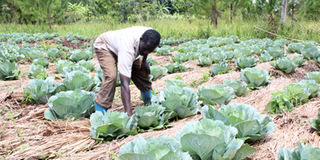Harvesting rainwater gives Otuke farmers better yields

Boost their yields. Photo by FARAHANI MUKISA.
What you need to know:
Imagine vegetables growing in a place that is very hot and dry. With rainwater harvesting, it is possible.
Farmers in Otuke District are predominantly growers of cereals such as millet, sorghum and simsim, and other legumes like groundnuts and pigeon peas. Most of these crops are grown using traditional methods where the farmers depend on rainfall.
For the last one year, many farmers have embraced growing food crops with a shorter maturity period and are changing their household food security and livelihood.
Although Otuke is characteristically semi-arid, the introduction of water-smart agriculture has enabled farmers like Milton Ocen to growing crops like vegetables, which were previously perceived not able to grow there.
Ocen, 45, a resident of Orum Sub-county, is one of the farmers championing the growing of high value alternative crops such as cabbage, tomatoes, onions and bananas, among others, using the low cost-water management technologies.
His story is one of the success stories shared by different farmers, who have tested the water-smart agriculture that is being piloted by Care International. “Initially I was growing rice but the yields were not matching my expectations,” Ocen says. For a family with nine children, the harvests were only sufficient for home consumption with little left for the market to meet other needs.
This was because he depended on seasonal rainfall and had hardly any knowledge about soil-water conservation methods. However, Ocen has diversified from growing rice to a variety of crops, which he can grow throughout the year using harvested rainwater.
“I was trained on the best soil conservation methods like mulching and tapping rain water, which has helped me realise better yields. I no longer worry about the long dry spells because I grow crops using supplementary irrigation with water from my well,” he says. “It collects about 36,000 litres of water that helps me irrigate my crops during dry seasons,”
Sharing the skills
Ocen has passed on the skills to his Apit Penyek (No envy) group members, which comprises more than 30 members. For an area of about 86,000 people, Ocen believes what he has passed on will also be extended to others.
“I used to grow rice on an acre and get harvests worth Shs1m. At times, this place is too dry and we used to think that crops like cabbages can’t grow here at all,” says Ocen.
“But since we were trained on how to use the improved farming technologies, I am increasingly realising better yields and my family’s wellbeing is improving. I am now trying out water melons, onions and bananas.”
Challenges
However, what many other farmers are worried about is access to markets, which is worsened by the poor infrastructures like roads. “Sometimes there are bumper harvests but the markets are very far. We lack transport means to deliver to markets and the harvest ends up rotting houses and in granaries,” Ocen laments.
For a region that experienced a 20-year civil war, such projects are a stepping stone for the government to pick lessons from and extend to other semi arid areas. This is the observation of Alan Nicol, programmes director, Global Water Initiative–East Africa, which is hosted at Care International.
“Government needs to incorporate these technologies into its programs to boost household farming at least in the entire Northern Uganda,” he says.
While Anthony Otude, project manager Welthungerhilfe, notes water harvesting had demystified many things about farming in Otuke. He adds they are crafting ways to let the community adopt and own the piloted technologies to ensure sustainability.
His organisation spearheaded research on the most cost-effective soil and water conservation technologies and practices in Otuke District.
Farmers’ experiences
Lily Obua: “I am Lily Obua, 48, a mother of seven and a resident of Olilim Sub-county. I grow cabbage and onions. Before that, I was growing cassava, millet and other cereals. Our faming mainly depended on rainfall and sometimes crops were drying when the rainy seasons were short. However, when I was taught how to harvest rainwater and use it to irrigate the crops during the dry spells, I have realised good results.
Through Care International, I learnt methods like mulching, raised ridges and use of farm-made compost manure. I want to try a variety of food crops to make sure my family’s diet is supplemented. I belong to Obangaatwero group, which has more than 20 farmers. It is through this group that we share the knowledge and pool resources.
Loy Atigo: My name is Loy Atigo, 30, with four children. I live in Orum Sub-county. I have two gardens of tomatoes. Initially I was growing millet and ground nuts, but now I grow tomatoes and bananas. I used to think such crops could not grow in our area. But after being convinced to try water harvesting, mulching and raised ridges, I have realised a change in both the quality and quantity of my crop yields.
Together with members of my group, Mi Wa Ongee, I know how to prune my crops and conserve the soils for continuous farming. Tomatoes in our region are expensive and I want to use this opportunity to sell them and construct a permanent house with an iron sheet roof.
What is water smart agriculture?
It is a combination of different low-cost effective technologies and practices of water management that can reduce farmers’ vulnerability (to unreliable rainfall) and enhance their productivity. It involves digging water ponds or installing water tanks to harvest water when in plenty and reuse in scarcity.
It also includes conservation farming such as raised planting ridges, mulching and use of compost manure.




